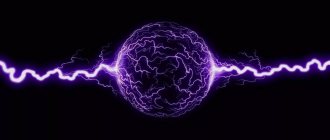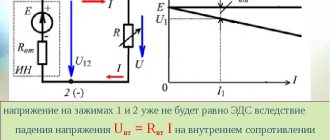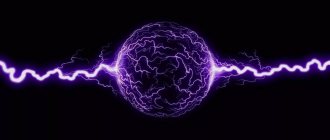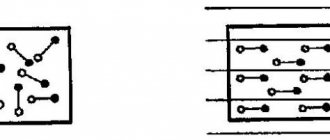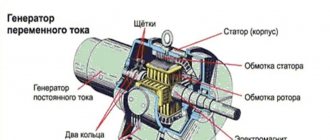Air gap breakdown
Breakdown of the air gap is a consequence of impact ionization. The electric field strength at which impact ionization occurs, leading to the formation of electron avalanches, is called the initial strength.
Due to the different mobility of electrons and positive ions formed under the influence of impact ionization, a space charge appears in the gap, which distorts the electric field. With a further increase in the voltage applied to the gap, breakdown occurs, and the degree of inhomogeneity of the electric field has a significant influence on the breakdown voltage.
In the case of electrodes that form a nearly uniform electric field at small discharge gaps, the occurrence of impact ionization instantly leads to breakdown of the gap, that is, breakdown of air occurs without the development of processes complementing the breakdown. Under such conditions, the breakdown voltage coincides with the initial field strength.
A non-uniform electric field is characterized by the presence of three stages in the development of air breakdown. Compared to a uniform field, the initial voltage here is significantly lower. As a result of impact ionization, a corona discharge (local ionization) occurs in places with maximum field strength, accompanied by a glow. With increasing voltage, the corona discharge turns into a brush discharge, in which the glow is not concentrated around the electrode, but spreads in the form of separate beams emanating from one electrode, but not reaching the other. With a further increase in voltage, the brush discharge short-circuits both electrodes. A spark forms between the electrodes, indicating a complete breakdown of the air gap. If the power of the voltage source is sufficient, the spark turns into an electric arc. The development of the above processes leads to a noticeable decrease in the breakdown voltage of the air gap compared to a uniform electric field, all other things being equal.
The electrical strength of air gaps depends not only on the degree of inhomogeneity of the electric field, but also on temperature, pressure and air humidity. For example, the amplitude value of the breakdown voltage Upr of air at a frequency of 50 Hz in a uniform field, MV, is determined by the empirical formula:
The greatest degree of electric field inhomogeneity is inherent in rod-plane and rod-rod systems.
Air breakdown mechanism
1
PHYSICS AND CHARACTERISTICS OF LIGHTNING PROCESSES
Under natural conditions, air is a good insulator. This property of air is used when building overhead power lines.
For current to flow through any material, there must be free charges in the material. The lightest of them is the electron. The electron is the fastest and most efficient carrier of electric current. Ions (ionized atoms or molecules) are several thousand times heavier than an electron, so their speed in an electric field is hundreds of times less than that of electrons.
Under normal conditions, each cubic centimeter of air contains about 10 electrons and about 1000 ions. In the lightning , the electron density increases approximately 1014 times. To better understand this huge figure, we can make the following comparison: mentally increasing the radius of the atom by 1014 times, we get a ball with a radius of 10 km
.
Where does such an armada of electrons come from in the lightning ? The answer is simple: we need to extract electrons from atoms. The simplest of them, the hydrogen atom, has one electron; nitrogen and oxygen (the main components of air) have 7 and 8 electrons, respectively. In every cubic centimeter of air at normal pressure there are 2.6 * 1019 molecules. So there are enough electrons, you just need to be able to extract them from atoms.
Let's consider how difficult this is. Let's take a hydrogen atom with one electron in its orbit. According to reference data, the electron of hydrogen carries a negative charge
e=
-1.6*10-19 Cl. This is the smallest charge in nature. The atom is neutral because its nucleus contains a positively charged proton with a charge equal to an atom. The radius of an atom is about 10-8 cm. It is at this distance that the electron rotates around the proton. There is an attractive force between them, which is calculated according to Coulomb's law
where ke —
proportionality coefficient, equal for air and other gases 9 * 109, if the charges are represented in coulombs, and the distance between them is in meters.
Then, taking into account that q1 = q2
, we get
. (1)
To remove an electron from an atom, such a force must be applied. This force may be contained in the electric field of a charge in a thundercloud.
In this case, the characteristic of electric field strength is usually used. It shows how many volts act per unit length of the insulating gap if voltage U
Therefore, if the length of the interval is equal to
d
, then
and is measured in volts per meter (V/m)
In very primitive experiments with an electrified comb, an air breakdown voltage of 30 kV/cm was obtained.
As is known, the field strength acts on a charge with a force
. (2)
If this is the electron charge q
, That . Now you can understand what field strength you need to have in order to tear an electron away from an atom. To do this, let’s equate (1) and (2):
.
e= into this formula
-1.6*10-19 C,
ke
= 9*109,
r
=10-8 cm=10-10 m, we get:
/m=1.440.000 kV /cm.
This is a fantastic level of electric field! This means that in order to snatch an electron from an atom, it is necessary to create the same external field.
How does an electrified comb manage to do this? After all, her field is 50,000 times smaller!
The whole secret is in the mechanism of electron removal.
Consider this natural secret.
If an electric field is applied to the air gap, the electron will move under its action, colliding with the atoms of the molecules. While the speed of the electron is low, its collisions with atoms are elastic, and the electron, like a tennis ball, bounces off the atom. The picture changes dramatically when the electron accelerates so much that, as a result of its kinetic energy given off upon impact, it can knock the electron out of the atom. This process is called impact ionization. In atmospheric air, impact ionization occurs at an electric field strength of approximately 30 kV/m. This has been proven both theoretically and experimentally.
As mentioned above, there are about 10 electrons in 1 cm3 of air. if at least one of the atoms accelerates to a state where it is capable of knocking out another electron from the atom, two free electrons appear, each with enough energy to knock out 1 electron each from the next atoms, and this already turns out to be 4 electrons. Then the process is repeated, but in each subsequent case the number of electrons doubles: 1, 2, 4, 8, 16, 32, 64, 128, 256, 512, 1024, 248, that is, the process of formation of new electrons increases like an avalanche. Accordingly, the air becomes more and more conductive.
Observations show that there are several avalanches simultaneously in the air gap; at very high electric field strengths, their number can be very large. This process is called electrical breakdown of air.
1
Date added: 2017-11-21; views: 867; ORDER A WORK WRITING
Find out more:
Electric strength of dielectrics
⇐ PreviousPage 7 of 8Next ⇒
6.1. Basic calculation expressions and necessary explanations
Electric strength ( E
etc.) is the average electric field strength at which electrical breakdown of the insulating gap occurs.
The voltage at which electrical breakdown occurs is called “breakdown voltage” ( U
pr).
(6.1)
where h
– dielectric thickness (insulating gap between electrodes, discharge gap).
The breakdown voltage depends on the size of the discharge gap. As the gap increases, the breakdown voltage increases and the dielectric strength decreases.
Electrical breakdown of a dielectric is an abrupt increase in the electrical conductivity of a material when exposed to high voltage, up to the formation of an electrically conductive plasma channel. The phenomenon of electrical breakdown in gases or liquids is often called “electric discharge,” which refers to the discharge of a capacitance through this channel.
The mechanisms of discharge development in gaseous, liquid and solid dielectrics are different.
During electrical breakdown of a large gas gap, the following phenomena sequentially develop.
I. Appearance of a free electron
in a gas gap (random, from a metal electrode, as a result of photoionization of a gas molecule, etc.).
II. Acceleration of a free electron by an electric field to an energy sufficient to ionize the latter upon collision with a neutral atom ( impact ionization
).
III. Development of the electron avalanche
as a consequence of multiple acts of impact ionization.
IV. Streamer growth
– a conducting plasma channel formed from positive ions remaining after the passage of an avalanche, and negative charges drawn into the positive plasma.
V. Converting a streamer into a leader
due to thermal ionization caused by the passage of capacitive current through the streamer.
VI. Main rank
occurs when the discharge channel closes the discharge gap.
At short intervals, the breakdown process can be completed at stages III (avalanche breakdown) and IV (streamer breakdown, spark).
The electrical strength of gases depends on:
A) from pressure
.
As pressure increases, the distances between molecules decrease. An accelerating electron needs to obtain the same energy sufficient to ionize the atom over a shorter acceleration path (called the mean free path). This energy is determined primarily by the final (at the moment of collision) speed of the electron. An electron can achieve greater acceleration by increasing the force acting on it - the electric field strength. The experimental dependence of the breakdown voltage of a gas gap on the product of pressure p
and the gap value
h
is called Paschen's law.
The minimum value of the breakdown voltage for air at ph
= 0.7 Pa m is approximately 330 V. To the left of the indicated
ph
, the electrical strength increases due to the low probability of collisions of electrons with gas molecules.); The Paschen curve is shown in Fig. 6.1
| 0,1 |
| 0,1 |
| Product ph for air, Pa m |
| Rice. 6.1. Paschen curve for avalanche breakdown of an air gap |
At pH
~ 10 Pa m or more, you can use the following approximate formula to calculate the breakdown voltage:
, (6.2)
where parameters a
0 and
b
0 depend on the type of gas (Table 6.1).
Table 6.1
Coefficients of the empirical formula for breakdown voltage
| Constant odds | Air | O2 | N2 | H2 | Ar | He | Ne | SF6 |
| a 0, MV/m | 2,45 | 2,6 | 2,35 | 1,26 | 0,57 | 0,57 | 0,201 | 8,93 |
| b 0, MV/m1/2 | 0,064 | 0,0635 | 0,0955 | 0,0437 | 0,226 | 0,0153 | 0,0157 |
Here we assume pressure p
0 = 101.3 kPa, temperature
T0
= 293 K.
When temperature and pressure change, the previous formula is modified:
, (6.3)
Where ;
B) from affinity
gas molecules to electron, gas electronegativity. (Electron affinity is the ability of some neutral atoms and molecules to attach additional electrons, turning into negative ions. In electronegative gases, consisting of atoms with high electron affinity, greater energy is required to accelerate the electrons by the field to form an electron avalanche.)
The electrical strength of a liquid dielectric is not directly related to the chemical structure of liquids. Due to the close arrangement of molecules in a liquid dielectric, the mechanism of impact ionization is not realized.
The value of electrical strength is influenced primarily by the amount of gas in the liquid, the condition and surface area of the electrodes.
Electrical breakdown of a liquid dielectric begins, as a rule, with the breakdown of microscopic gas bubbles. Due to the low dielectric constant of the gas, the tension in the bubble is higher than in the liquid, and the electrical strength of the gas is lower.
Partial discharges in bubbles lead to their growth, which ultimately results in breakdown of the liquid dielectric.
The electrical strength of a liquid dielectric increases:
– when cleaning from solid conductive microparticles (soot, coal, etc.);
– drying liquids (removing water);
– degassing of liquid (vacuuming);
– increase in pressure P
.
To take into account pressure P
and electrode area
S,
a generalization of empirical dependencies is used in the form of
the Martin formula
.
, (6.4)
where the constant M
depends on the type of liquid and has a dimension MV/cm.
In this expression, the pulse duration τ should be substituted in microseconds, the pressure in atm, and the electrode area S
in cm2.
Constant M
is 0.7 MV/cm for hexane and transformer oil, 0.6 MV/cm for glycerin, 0.5 MV/cm for ethyl alcohol, 0.6 MV/cm for water (in case of breakdown with cathode) and 0.3 MV/cm (in case of breakdown from the anode).
mechanisms of solid dielectrics depend on the time of exposure to voltage (from the moment of application to breakdown), which determines the physical processes occurring during this exposure. There are:
– electrical breakdown (exposure time – fractions of a second);
– thermal breakdown (exposure time from seconds to hours);
– breakdown under the influence of partial discharges (exposure time from several hours to a year or more).
During electrical breakdown of a solid dielectric under the influence of an applied voltage, chemical bonds are broken, and the substance is processed into plasma. The electrical strength of a solid dielectric is proportional to the energy of chemical bonds.
The cause of thermal breakdown is heating of the dielectric, most often due to dielectric losses, when the power loss exceeds the power removed from the dielectric.
As the temperature rises, the electrical conductivity (due to an increase in the number of carriers) and the dielectric loss angle increase, which leads to an additional increase in energy release and a decrease in electrical strength.
A partial discharge (PD) is a discharge that occurs in a limited area of the insulating gap and does not close the entire gap. One example of a partial discharge is a corona discharge in gases in a non-uniform electric field, when only an area near an electrode with a field strength higher than the electrical strength of the gas (for example, near a high-voltage power transmission line) is penetrated by a streamer. In solids, PD is a local multi-avalanche discharge in a gas pore of a dielectric.
For a partial discharge to occur in a solid dielectric, two conditions are necessary:
– the presence of an air inclusion, the field strength in which is higher than in the dielectric itself;
– the voltage applied to the dielectric must be sufficient for the field strength in the air inclusion to exceed the breakdown strength.
When an alternating field is applied to a dielectric, partial discharges occur at each half-cycle when the voltage reaches the breakdown value. Long-term periodic PD chemically destroys the dielectric, increases dielectric losses, which ultimately leads to breakdown of the dielectric.
To determine the field strength, insulation of a coaxial cable, you can use the expression
, (6.5)
where r
– distance from the cable axis to a point in the insulation;
r
2 – radius of the external electrode;
r
1 – radius of the internal electrode.
⇐ Previous7Next ⇒
Recommended pages:
Use the site search:
Solid dielectrics.
Typical solid electrical insulating materials include porcelain, glass, quartz, natural and synthetic rubber, and plastics. Thin layers of solid insulators can have very high breakdown voltages and electrical resistivities, as can be seen from the table below.
Increasing the applied potential difference across the sample of solid or liquid dielectric in question increases the current through it.
This increase leads to the abstraction of electrons and the formation of a positive spatial charge near the cathode. Electrical breakdown results from distortion of the electric field inside the insulator. Both solid and liquid dielectrics are subject to polarization, i.e. their dielectric constant is greater than unity. Polarization leads to the appearance of dielectric losses when alternating electric fields are applied. Some materials, such as quartz, polyethylene and some gases, have very low dielectric losses even in high-frequency electric fields. Table: Properties of solid dielectrics
| PROPERTIES OF SOLID DIELECTRICS | |||
| Material | Electric strength, kV/cm | The dielectric constant | Electrical resistivity, 1014 OhmHcm |
| Mica | 280 | 5,0–7,0 | 2000 |
| Glass (various) | 200–700 | 3,0–12,0 | 10–6 ё104 |
| Methyl methacrylate (Lucite) | 650 | 3,3–4,5 | 1 |
| Porcelain (unglazed) | 130 | 5,0–7,0 | 3 |
| Ebonite | 650 | 2,0–3,5 | 104 |
Breakdown of gaseous dielectrics in a non-uniform field
Features of breakdown of gaseous dielectrics in a uniform field.
The field is uniform if the field strength vector is the same at all its points. In practice, a uniform field is extremely rare. The electrical strength of gases depends significantly on a large number of different external factors.
Dependence of the electrical strength of gases on pressure. The dependence of the electrical strength of a gas on pressure is explained by a change in the concentration of molecules per unit volume, leading to a change in the electron mean free path λ
.
In the region of atmospheric pressure, the dependence Epr(p)
is practically linear and loses linearity in regions close to vacuum.
Dependence of the electrical strength of gases on the distance between the electrodes. When the distance between the electrodes Epr
increases rapidly, which is explained by the difficulty of forming a discharge in a small gap. The electrons do not have time to gain the energy necessary for ionization before colliding with the anode.
The shape of the electrodes significantly affects the electrical strength of gases, which is explained primarily by the inhomogeneity of the electric field and the appearance of local overvoltages.
The dependence of the electrical strength of air on the frequency of the applied voltage occurs only in the range of ultrasonic frequencies, radio frequencies and microwave frequencies. In the industrial frequency range, the electrical strength of gas is practically independent of voltage frequency.
A non-uniform electric field occurs between electrodes of the rod-plane type, rod-to-rod type, and between the wires of overhead power lines. Areas with high electric field strength are often formed due to inhomogeneity of the electric field arising from:
1) When choosing incorrect parameters during the design process
2) As a result of contamination arising during operation
3) As a result of mechanical damage and equipment wear
In practice, we usually have inhomogeneous electric fields. Gas breakdown in a non-uniform field is preceded by the appearance of a corona discharge, which is actually an incomplete breakdown. Corona discharge is a phenomenon associated with the ionization of air in an electric field with high intensity (glow of gases in a non-uniform electric field of high intensity). Similar fields are formed at electrodes with very large surface curvature (points, thin wires). When the field strength reaches the limit value for air (about 30 kV/cm), a glow appears around the electrode, looking like a shell or crown (hence the name). The resulting discharges initially do not reach the second electrode. As the voltage increases, the corona discharge turns into a spark discharge, and then into an arc discharge.
The conditions for the occurrence of corona and gas breakdown in a non-uniform field depend on the polarity of the voltage applied to the rod electrode. With a positive polarity of the rod electrode, corona appears at lower voltages. As humidity increases, the breakdown voltage of the air gap increases.
The occurrence of a corona discharge on power lines is undesirable, as it causes significant losses of transmitted energy. In order to reduce the relative curvature of the electrodes, multi-wire lines (3, 5 or more wires arranged in a specific way) are used.
High voltage capacitors.
High voltage capacitors used in radio transmitting devices often use mica as an insulator. Capacitors for very high voltages are usually made of metal foil with many layers of dielectric paper placed in an oil-filled container, or of metal plates separated by a gaseous or liquid dielectric. In such designs for high-frequency capacitors, in which it is important to have low dielectric losses, vacuum is also used as a dielectric.
Basic concepts about breakdown
Laboratory work No. 7
In the discipline "Materials Science"
On the topic: “Determination of the electrical strength of gaseous dielectrics.”
Teacher:
Belyanov A.V.
Goal of the work:
1. Experimental study of the characteristics of the breakdown of gaseous dielectrics in homogeneous and inhomogeneous electric fields.
2. Study of the electrical strength of gaseous dielectrics in homogeneous and inhomogeneous electric fields.
Questions:
1. How does the process of electrical conductivity occur in gaseous dielectrics?
2. Why do dielectrics lose electrical strength? What parameters characterize a breakdown? Explain the mechanism of air breakdown.
3. What are the processes of electrical, electrothermal, electrochemical and ionization breakdown
4. What are the advantages of gaseous dielectrics over other types of electrical insulating materials.
5. What is called polarization of a dielectric. Which types of polarization can be considered instantaneous and which delayed? Establish a relationship between types of polarization and the mechanism of dielectric losses?
6. Will the breakdown voltage of air change the same if it is heated: a) at constant pressure; b) at constant volume.
7. How does gas pressure affect its electrical strength and ionization losses?
8. What is the difference between gas breakdown in a uniform and inhomogeneous electric field? How can a uniform field be created in a gas? Why does the breakdown voltage of a gas in a uniform field increase as the distance between the electrodes increases?
9. Which electrical devices use air as a dielectric? Explain why other gases are used as electrical insulating materials? Give examples.
10. What effect does the shape of the electrodes have on the electrical strength of air?
11. Under what conditions does an independent gas discharge occur?
12. Under what conditions is Ohm’s law observed for electrical insulating materials?
13. Graphically depict the dependence of the breakdown voltage of air on the distance between the electrodes at constant pressure. How will the appearance of the graph change if the pressure becomes less than the original?
14. Graphically depict the dependence of gas breakdown voltage on pressure at various distances between the electrodes.
15. How does electrothermal breakdown occur and occur? On what factors does the magnitude of the breakdown voltage during electrothermal breakdown depend?
16. How does the breakdown voltage depend on the frequency of the applied voltage and the ambient temperature?
17. What processes are responsible for the occurrence of ionization breakdown? What dielectrics is it typical for?
18. What factors explain the reason for the transition of electrical breakdown to the region of thermal breakdown?
19. How does the breakdown voltage of air change at the interface with a solid dielectric?
The report must contain:
1. Schematic diagram of the laboratory installation
2. Test results tables: 1, 2, 3.
3. Graphs of the dependence Upr=f(h) and Ep=f(h) for air in a uniform and inhomogeneous electric field
4. Conclusions
Basic concepts about breakdown
A dielectric exposed to an electric field of not too high intensity is a non-conducting medium. The dielectric loses its electrical insulating properties if the field strength exceeds a certain critical value. The formation of a conducting channel in a dielectric under the influence of an electric field is called electrical breakdown. In this case, the dielectric is destroyed, as a result of which the dielectric goes from a non-conducting state to a highly conductive state. Not the entire sample will be in this state, but only a narrow channel directed from electrode to electrode.
At ordinary voltages, the volt-ampere characteristic of the dielectric sample is linear, but as U approaches Upr it deviates from linear (Figure 1)
Figure 1 – Volt-ampere characteristic
during dielectric breakdown.
At the moment of breakdown, the leakage current through the dielectric increases sharply, and the insulation resistance decreases accordingly, so that dI/dU®¥.
A spark or electric arc occurs at the site of the breakdown. As a result, a highly conducting channel is formed between the electrodes and the sample becomes short-circuited, and the voltage begins to drop, despite the increase in current.
The voltage at which breakdown of the dielectric occurs is called breakdown Upr, and the corresponding value of the electric field strength is called the dielectric strength Epr.
The breakdown voltage Upr of electrical insulation depends on its thickness, i.e. on the distance between the electrodes: the thicker the layer of electrical insulating material, the higher the breakdown voltage. But different dielectrics of the same thickness have different values of the breakdown voltage Up.r.
Electrical strength Epr is the most important parameter of a dielectric material, characterizes the material’s ability to resist destruction in an electric field and is widely used in the calculations and design of electrical insulation, machines, transformers, cables, capacitors and other devices, as well as for assessing their reliability and durability
For the simplest case of a uniform electric field, the dielectric strength is calculated using the formula:
Epr = Upr/h (1)
where Epr – electrical strength V/m; MV/m
Upr – breakdown voltage, V;
h – dielectric thickness at the breakdown site, m.
For reliable operation of any electrical device, the operating voltage of its insulation Urab must be significantly less than the breakdown voltage. The ratio Upr/Urab is called the safety factor.
Digital library
General engineering disciplines / Materials science, technology of structural materials / 9.2.4 Dielectric breakdown
Basic concepts about breakdown
We examined various physical phenomena that occur in a dielectric under the influence of an electric field of not too high intensity, when the dielectric remains a practically non-conducting medium. However, electric field forces with a corresponding increase in tension can lead to a violation of this state. As a result, the dielectric will go from a non-conducting state to a highly conductive state, but not the entire sample to which voltage is applied, but only a narrow channel directed from one electrode to another.
The phenomenon of formation of a conducting channel in a dielectric under the influence of an electric field is called breakdown
.
The breakdown can be complete
if the conductive channel passes from one electrode to another and closes them,
incomplete
if the conductive channel does not reach at least one of the electrodes, and
partial
if only a gas or liquid inclusion of a solid dielectric breaks through.
In solid dielectrics, in addition to breakdown by volume, breakdown along the surface (in a gas or liquid), called surface breakdown
.
The minimum voltage applied to a dielectric sample that leads to its breakdown is called breakdown voltage
().
Current-voltage characteristic of a dielectric (or electrical insulation) sample, linear at ordinary voltages ( U
), deviates from linear as
U
approaches
Unp
(Fig. 9.13). At the moment of breakdown, the current through the dielectric increases sharply, so that . A spark or electric arc occurs at the site of the breakdown. Due to the formation of a plasma highly conductive breakdown channel between the electrodes, the sample becomes short-circuited, and the voltage across it drops, despite the increase in current.
Rice. 9.13. Current-voltage characteristics of electrical insulation
If a breakdown occurs in a gaseous or liquid dielectric, then due to the mobility of molecules, the punctured area, after removing the voltage, restores its original properties and the value of U p p
(but provided that the power and duration of the electric arc were not so significant as to cause significant changes in the dielectric throughout its entire volume). After a breakdown of a solid dielectric, a trace remains in it in the form of a punched (hence the name “breakdown”), burned through or melted hole, most often of irregular shape. If the voltage is applied again, the breakdown, as a rule, occurs at the previously pierced place at a significantly reduced voltage.
In some cases, after a dielectric breakdown, conductive decomposition products remain in the breakdown channel, and the dielectric loses its electrical insulating properties. Damage to the surface of a solid dielectric due to surface breakdown associated with the formation of conductive traces (“tracks”) is called tracking
.
The rated voltage of the electrical insulation must be less than the breakdown voltage. The value equal to the ratio of the breakdown voltage to the rated voltage is called the electrical safety factor
.
Unp value
dielectric is directly related to the time of voltage application. Thus, with short-term pulses, breakdown occurs at higher voltages than in the case of a constant or long-term applied alternating voltage.
Prolonged exposure to a high-intensity electric field leads to irreversible processes in the dielectric, as a result of which its breakdown voltage decreases, i.e. electrical aging of the insulation occurs
.
Due to this aging, the insulation has a limited service life. The curve of Unp
versus the time of application of voltage is called
the life curve of electrical insulation
.
The breakdown voltage ( Unp
) increases with increasing dielectric thickness
h
.
To characterize the ability of a material to resist destruction in an electric field, the concept of electric field strength at which breakdown occurs is introduced:
. (9.17)
The intensity of a uniform electric field leading to breakdown is called electrical strength
.
Electrical strength ( Epr
) is one of the most important parameters of an electrical insulating material.
The breakdown mechanisms of gaseous, liquid and solid dielectrics have significant differences.
Gas breakdown
The number of electrons formed within 1 s in 1 cm3 of air under the influence of radioactivity of the Earth or cosmic rays ranges from 10 to 20. These electrons are the initial charges leading to breakdown of the gas in a strong field. As the electric field strength increases, the electrons between two collisions acquire energy sufficient to ionize gas molecules.
At given values of gas pressure and temperature, impact ionization begins at a certain field strength. This field strength ( E
) is called
the initial tension
.
In some gases (for example, oxygen, carbon dioxide, water vapor), the separated electron, during one of the next encounters with another neutral molecule, combines with it, turning it into an electronegative ion.
The main ionization is carried out by electrons. As a result, when they collide with atoms and molecules, they generate new electrons. The “secondary” electrons released under the influence of the field, in turn, cause the ionization of gas molecules. As a result of this process, the number of electrons in the gas gap, increasing like an avalanche, increases very quickly. Impact ionization by electrons forms the basis of gas breakdown.
A feature of gas breakdown in a non-uniform field is the occurrence of a partial discharge in the form of a corona
in places where the field strength reaches critical values, with a further transition of the corona into a spark discharge and arc as the voltage increases.
Air breakdown at the surface of a solid dielectric, called surface flashing in technology, usually occurs at lower voltages than in the case when there is only air between the electrodes. The value of the discharge voltage is influenced by the shape of the electric field, determined by the configuration of the electrodes and dielectric, voltage frequency, state of the dielectric surface, and air pressure.
Breakdown of liquid dielectrics
Liquid dielectrics have significantly higher breakdown voltages than gases under normal conditions. The breakdown mechanism and the electrical strength of dielectric liquids depend primarily on their purity. Electrical breakdown of thoroughly purified liquids under short-term exposure to an electric field occurs due to a combination of two processes: impact ionization by electrons and cold emission from the cathode. In accordance with this, the electrical strength of thoroughly purified liquids is two orders of magnitude higher than gases, and is approximately 100 MV/m. This is explained by the fact that a higher field strength is required in order for an electron, moving in a denser medium with a shorter mean free path ( λ
), has accumulated energy sufficient for ionization.
The nature of the breakdown of contaminated and technically pure liquids is determined by processes associated with the movement and redistribution of impurity particles.
Under the influence of high voltage, these processes lead to the occurrence of secondary phenomena such as the formation of bridges from solid particles or gas bubbles, i.e. conducting channels. In particular, when a liquid operates in strong fields, especially high frequencies, it heats up and vapor bubbles form. Therefore, the nature of the breakdown of liquid dielectrics depends on many factors, determined largely by the type, size, quantity and distribution of impurities. The presence of bridges and chains of solid particles greatly distorts the field between the electrodes. As a result, liquid breakdown occurs in a non-uniform field, which, in turn, leads to a decrease in the electrical strength of the liquid.
Sharp decline in EPR
It also occurs when the liquid is contaminated with wet organic fibers (paper, textiles), since such fibers are capable of forming bridges with increased conductivity.
If the bridge comes into contact with one of the electrodes, then it serves as a needle-shaped continuation of this electrode, as a result of which the interelectrode distance decreases and the field inhomogeneity increases. In the case of “dry” fibers, the bridges have high resistance and have a lesser effect on the EPR
of the liquid. The most common impurity in liquid dielectrics is moisture, which can be in a dissolved or emulsified state.
Breakdown of solid dielectrics
The physical picture of the breakdown of solid dielectrics may be different in different cases. Along with ionization processes, secondary processes caused by a strong electric field (heating, chemical reactions, partial discharges, mechanical stresses as a result of electrostriction, the formation of space charges at the boundaries of inhomogeneities, etc.) can lead to breakdown. Therefore, several mechanisms of breakdown of solid dielectrics are distinguished: electrical, electrothermal, electrochemical and ionization.
Electrical breakdown
is a breakdown caused by impact ionization or breaking of bonds between dielectric particles directly under the influence of an electric field.
Electric strength ( Epr
) of solid dielectrics during electrical breakdown lies in a relatively narrow range - 100 - 1000 MV/m, which is close to
the Epr of
highly compressed gases and very pure liquids.
Epr
value is determined mainly by the internal structure of the dielectric (packing density of atoms, the strength of their bonds) and weakly depends on such external factors as temperature, frequency of the applied voltage, shape and size of the sample (with the exception of very small thicknesses). This type of breakdown is typical for macroscopically homogeneous dielectrics with low dielectric losses. A breakdown of this type occurs in no more than 10-7...10-8 s and is not caused by thermal energy. The value of electrical strength during electrical breakdown depends to some extent on temperature and is accompanied in its initial stage by the destruction of the dielectric in a very narrow channel.
Electrothermal
(
thermal
) breakdown is a breakdown caused by thermal processes occurring in a dielectric when exposed to an electric field and leading to the destruction of the dielectric. Thermal breakdown occurs when the amount of heat released in the dielectric due to dielectric losses exceeds the amount of heat that can be dissipated under given conditions; in this case, the thermal equilibrium is disturbed, and the process takes on an avalanche-like character.
The phenomenon of thermal breakdown comes down to heating the material in an electric field to temperatures corresponding to melting, cracking, charring, etc. The value of breakdown voltage during thermal breakdown is a characteristic of not only the material, but also the product, as opposed to electric and ionization breakdown, where breakdown voltage can serve characteristics of the material, namely its electrical strength.
The breakdown voltage caused by heating the dielectric depends on the voltage frequency, cooling conditions, ambient temperature, etc. In addition, the electrothermal (breakdown) voltage depends on the heat resistance of the material. Organic dielectrics (for example, polystyrene) have lower values of “electrothermal” breakdown voltages than inorganic ones (quartz, ceramics), all other things being equal, if only due to their low heat resistance.
Electrochemical breakdown
caused by chemical processes leading to changes in the dielectric under the influence of an electric field. Chemical changes (aging) at high voltage occur due to electrolysis, the presence of ozone in the air, etc. Electrical aging is especially significant when exposed to direct voltage and is less noticeable when exposed to alternating voltage.
Ionization breakdown
– this is a breakdown caused by ionization processes due to partial discharges in the dielectric.
It is most typical for dielectrics with air inclusions (for example, paper insulation). At high field strengths in air pores, air ionization occurs, ozone and accelerated ions are formed, and heat is released. All these processes lead to the gradual destruction of insulation and a decrease in Epr
.
As indicated, in solid dielectrics, in addition to volumetric breakdown, surface breakdown
, i.e.
breakdown in a liquid or gaseous dielectric adjacent to the surface of solid insulation. Since the Epr of
liquids and especially gases is lower than
the Epr
of solid dielectrics, and the normal component of the electric field strength is continuous at the interface, then with the same distance between the electrodes in the volume and on the surface, breakdown will primarily occur along the surface of the solid dielectric.
To prevent surface breakdown, it is necessary to lengthen the possible discharge path along the surface. Therefore, the surface of the insulators is made corrugated, and non-metalized edges of the dielectric are left in the capacitors. The
surface UPR is also increased by sealing the surface of the electrical insulation with varnishes, compounds, and liquid dielectrics with high electrical strength.
Breakdown of macroscopically inhomogeneous dielectrics
Most dielectrics used in practice are characterized by inhomogeneities of various types. For example, ceramic dielectrics consist of several phases (crystalline and glassy), which have different electrical properties, and have a larger or smaller number of pores (air inclusions). Pressed and wound products have a layered structure; their alternating layers also have unequal dielectric properties.
Due to small Epr
,
ε
and
γ
gas inclusions of a porous dielectric located in a strong electric field, partial discharges arise (“ignite”) in these inclusions. It is the occurrence of these discharges that is often the main process leading to the breakdown of a porous dielectric (ionization breakdown).
To increase the electrical strength of porous dielectrics, they are impregnated, filling the pores with liquid or hardening electrical insulating material with high electrical strength. So, for unimpregnated cable paper Epr
= 3...5 MV/m, and for compound-impregnated
Epr
= 40...80 MV/m.
Liquid dielectrics.
Also on topic:
SILICON
Organic compounds, in particular hydrocarbons, are widely used as liquid dielectrics. Hydrocarbons are characterized by low dielectric constant (from 2 to 4) and moderately high electrical resistivity (approx. 1012 OhmHcm). Because hydrocarbons do not contain oxygen or nitrogen, they are chemically stable and therefore suitable for use in high electric fields in which ionization processes increase chemical instability. Examples of liquid dielectrics include cyclic hydrocarbons such as benzene (C6H6) or acyclic compounds such as hexane [CH3 (CH2)4CH3]. Most hydrocarbons occur as mixtures; the chemical composition and structure of their constituent components are not precisely known. These include, in order of increasing viscosity, petroleum ether, paraffin oil, transformer oils, paraffin and various waxes.
Some halogen derivatives, such as chloroform (CHCl3) and carbon tetrachloride (CCl4), are dielectrics. Liquid inorganic dielectrics include liquefied gases such as carbon dioxide and chlorine.
An important advantage of liquid dielectrics is their ability to restore their properties after a spark breakdown and their ability to conduct heat, which is important for transformers.
Vacuum as an insulator.
When metal electrodes are placed in a gas with a pressure of less than 10-2 Pa, there are not enough gas molecules to generate a noticeable current in the interelectrode gap, and in this case they speak of high vacuum insulation. Ionization of residual gas molecules upon collision with electrons or positively charged ions emitted from the electrodes rarely occurs at such pressures. Under high vacuum conditions at a constant voltage below 20 kV, breakdown may not occur on the cathode surface at a field strength of up to 5 MV/cm, and at the anode at a field strength several times higher. However, at higher voltages, the cathodic gradient at which breakdown occurs rapidly decreases. Breakdown between metal electrodes in a vacuum occurs due to the exchange of charged particles between the cathode and anode. An electron emitted from the cathode is accelerated by the electric field and strikes the anode, knocking out positive ions and photons. Positive ions and some photons fall on the cathode; The ions are accelerated by the electric field and cause the emission of secondary electrons. At a certain critical value of voltage and electric field gradient for a given electrode material, this process becomes unstable and spark breakdown occurs.
High-vacuum insulation is particularly widely used in electronics, both for accelerating low-energy electrons in conventional vacuum devices and for high-voltage applications in X-ray instruments and nuclear research accelerators.

